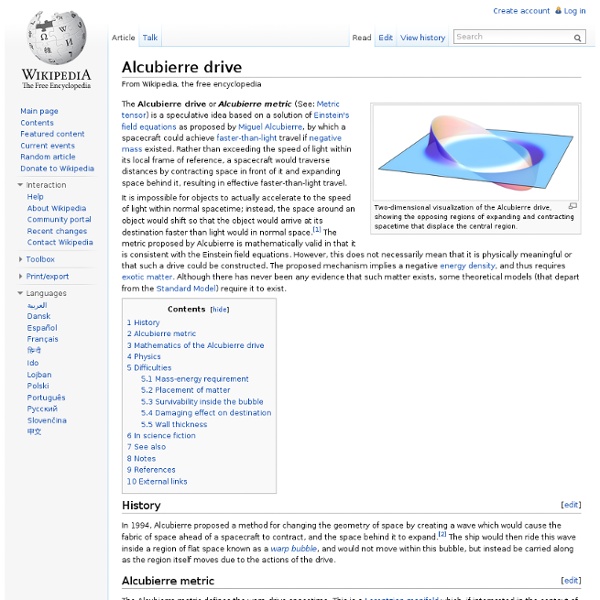Faster-than-light
Faster-than-light (also superluminal or FTL) communications and travel refer to the propagation of information or matter faster than the speed of light. Under the special theory of relativity, a particle (that has rest mass) with subluminal velocity needs infinite energy to accelerate to the speed of light, although special relativity does not forbid the existence of particles that travel faster than light at all times (tachyons). On the other hand, what some physicists refer to as "apparent" or "effective" FTL[1][2][3][4] depends on the hypothesis that unusually distorted regions of spacetime might permit matter to reach distant locations in less time than light could in normal or undistorted spacetime. Although according to current theories matter is still required to travel subluminally with respect to the locally distorted spacetime region, apparent FTL is not excluded by general relativity. FTL travel of non-information[edit] Daily sky motion[edit] Light spots and shadows[edit]
Wormhole
A wormhole, also known as an Einstein–Rosen bridge, is a hypothetical topological feature of spacetime that would fundamentally be a "shortcut" through spacetime. A wormhole is much like a tunnel with two ends each in separate points in spacetime. For a simplified notion of a wormhole, visualize space as a two-dimensional (2D) surface. In this case, a wormhole can be pictured as the 2D surface of a tube that connects different parts of the surface. The mouths of a wormhole are analogous to the holes at either end of the tube in a 2D plane. Researchers have no observational evidence for wormholes, but the equations of the theory of general relativity have valid solutions which contain wormholes. The American theoretical physicist John Archibald Wheeler coined the term wormhole in 1957; however, in 1921, the German mathematician Hermann Weyl already had proposed the wormhole theory, in connection with mass analysis of electromagnetic field energy.[12] Definition[edit] Time travel[edit]
Mustafa's Space Drive: An Egyptian Student's Quantum Physics Invention
Remember the name, because you might see it again: Aisha Mustafa, a 19-year-old Egyptian physics student, patented a new type of propulsion system for spacecraft that uses cutting edge quantum physics instead of thrusters. First, a little background: One of the strange quantum facts at work in Mustafa's engine idea is that there's no such thing as a vacuum, devoid of particles, waves, and energy. Instead the universe's supposedly empty spaces are filled with a roiling sea of particles and anti-particles that pop into existence, then annihilate each other in such a short space of time that you can't readily detect them. Mustafa invented a way of tapping this quantum effect via what's known as the dynamic Casimir effect. In terms of space propulsion, this is amazing. Aisha's invention is so promising that her university's staff aided with a patent application. [Image: Flickr user gordontarpley]
White–Juday warp-field interferometer
Motivation for the experiment[edit] The NASA research team lead by Harold White and their university partners currently aim to experimentally evaluate several concepts, especially a redesigned energy-density topology as well as an implication of brane cosmology theory. If space actually were to be embedded in higher dimensions, the energy requirements could be decreased dramatically and a comparatively small energy density could already lead to a measurable (i.e. using an interferometer) curvature of spacetime.[1] The theoretical framework for the experiment dates back to work by Harold White from 2003 as well as work by White and Eric W. Davis from 2006 that was published in the AIP, where they also consider how baryonic matter could, at least mathematically, adopt characteristics of dark energy (see section below). Theoretical framework[edit] The metric derived by Alcubierre was mathematically motivated by the cosmological inflation. Interferometer experiment[edit] Results[edit] [edit]
Faster than Light Travel
NASA’s NEXT ion drive breaks world record, will eventually power interplanetary missions
Proving yet again that Star Trek was scarily prescient, NASA has announced that its NEXT ion drive — NASA’s Evolutionary Xenon Thruster — has operated continually for over 43,000 hours (five years). This is an important development, as ion thrusters are pegged as one of the best ways to power long-term deep-space missions to other planets and solar systems. With a proven life time of at least five years, NEXT engines just made a very big step towards powering NASA’s next-gen spacecraft. Ion thrusters work, as the name suggests, by firing ions (charged atoms or molecules) out of a nozzle at high speed (pictured above). A diagram of an electrostatic ion thruster (as in NASA’s NEXT, and most other ion thrusters) With such puny thrust, a NEXT-based ion drive would need to run for 10,000 hours — just over a year — to reach a suitable speed for space travel. Moving forward, it now remains to be seen if NASA will use the NEXT on an actual spacecraft. [Image credit]
NASA Starts Work on Real Life Star Trek Warp Drive
New Wormhole Theory Uses Space Photon Energy “Fluid”
A new theory expands on other theories and adds photon energy “fluid” as a way to support wormholes. The introduction to the paper states the following. Wormholes are hypothetical geometrical structures connecting two universes or two distant parts of the same universe. For a simple visual explanation of a wormhole, consider spacetime visualized as a two-dimensional (2D) surface. “A possible cause of the late-time cosmic acceleration is an exotic fluid with an equation of state lying within the phantom regime, i.e., w = p/ρ < −1. FIG. 1: The plot depicts the function H(x, a), for α = 1/2 and where the parameter x = r0/r, lying in the range 0 < x ≤ 1, has been defined in order to define the entire spacetime. By using this theory an advanced civilization would , in theory, be able to mine photon “fluid” for Phantom Energy to construct micro worm holes for such things as transportation. Please enter the url to a YouTube video. 1. Related In "NASA"



